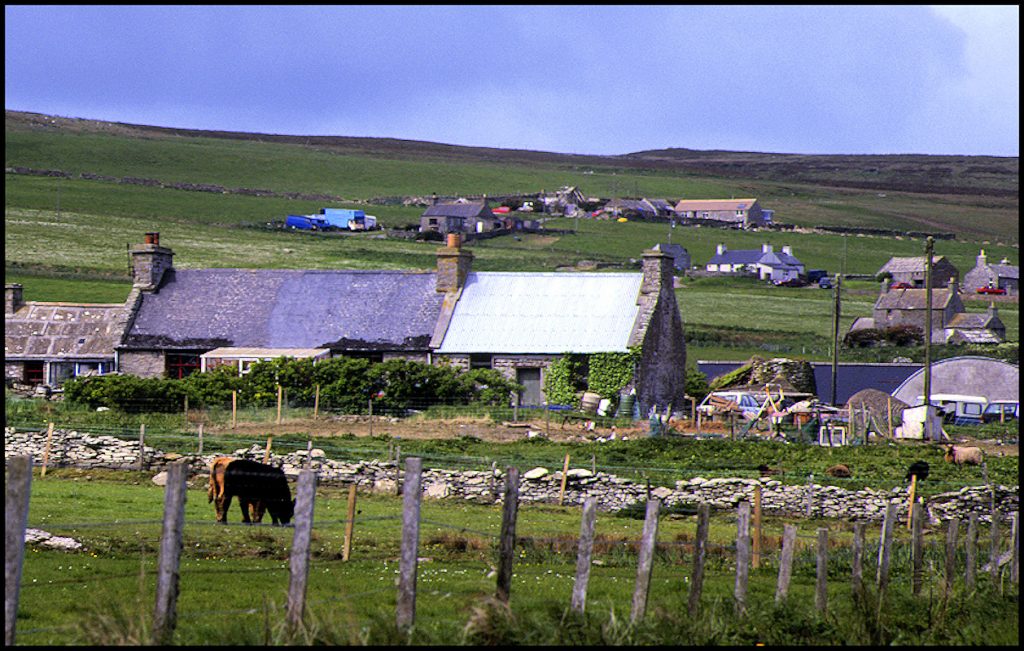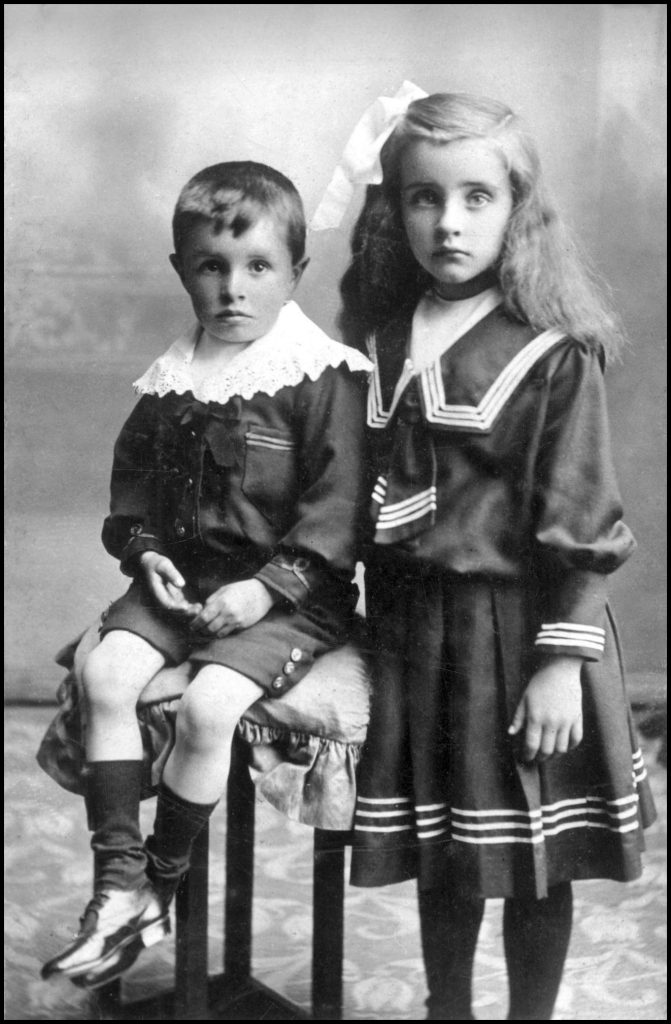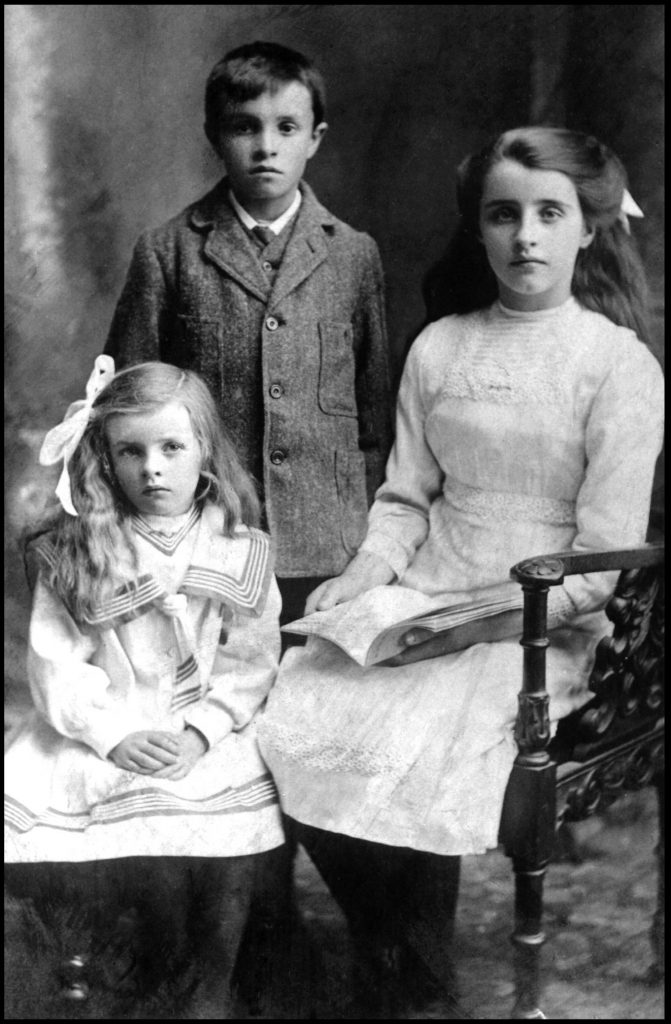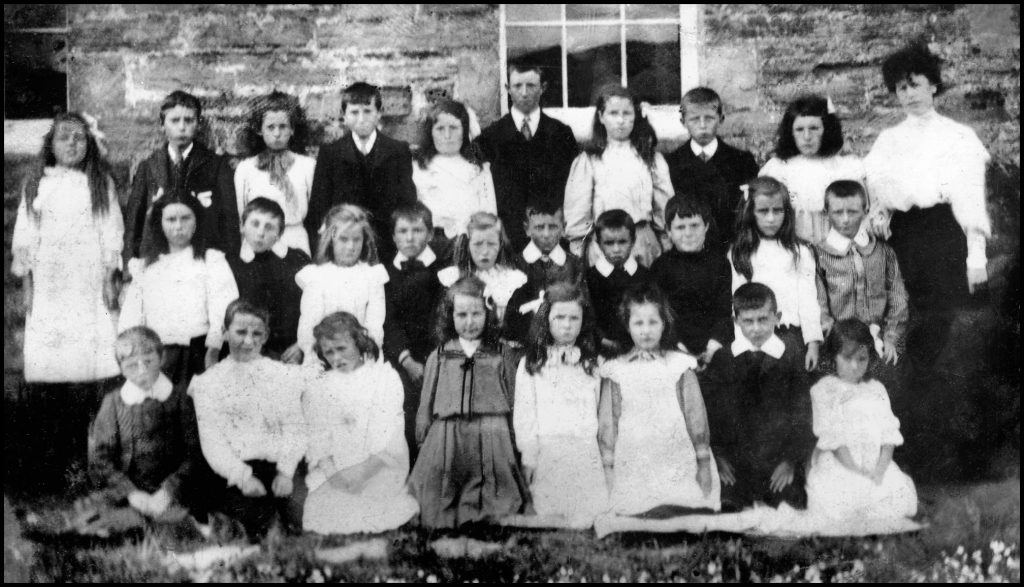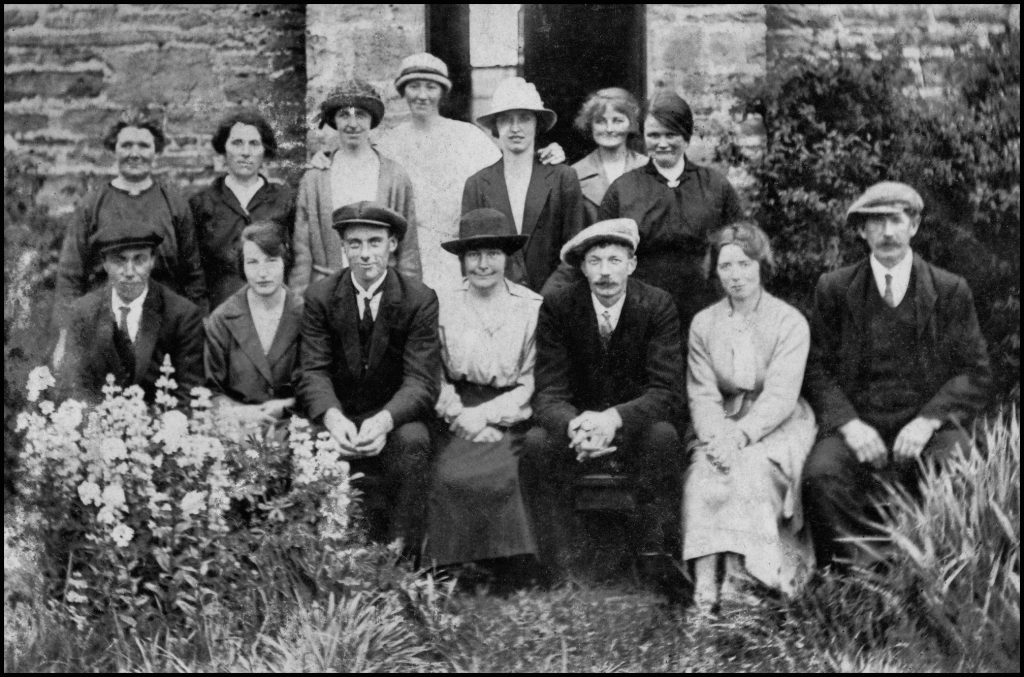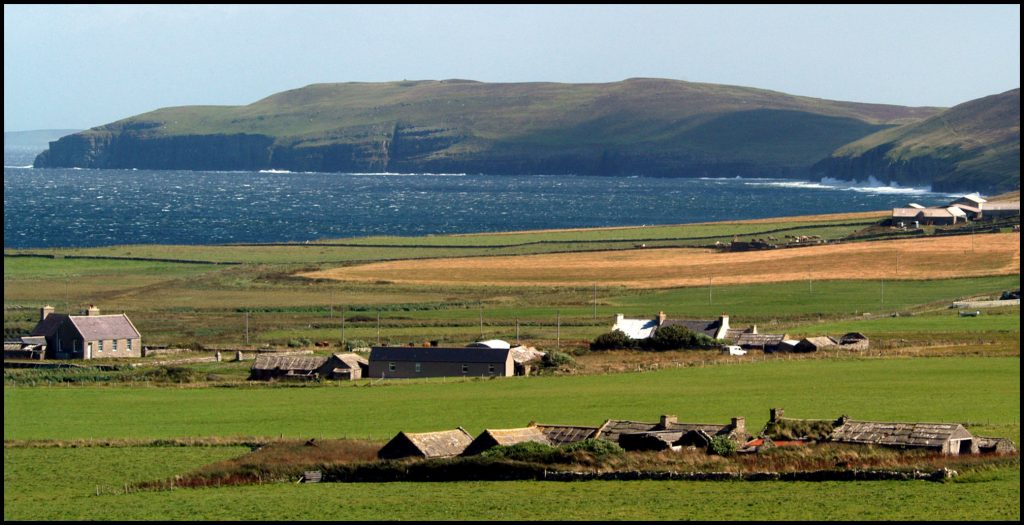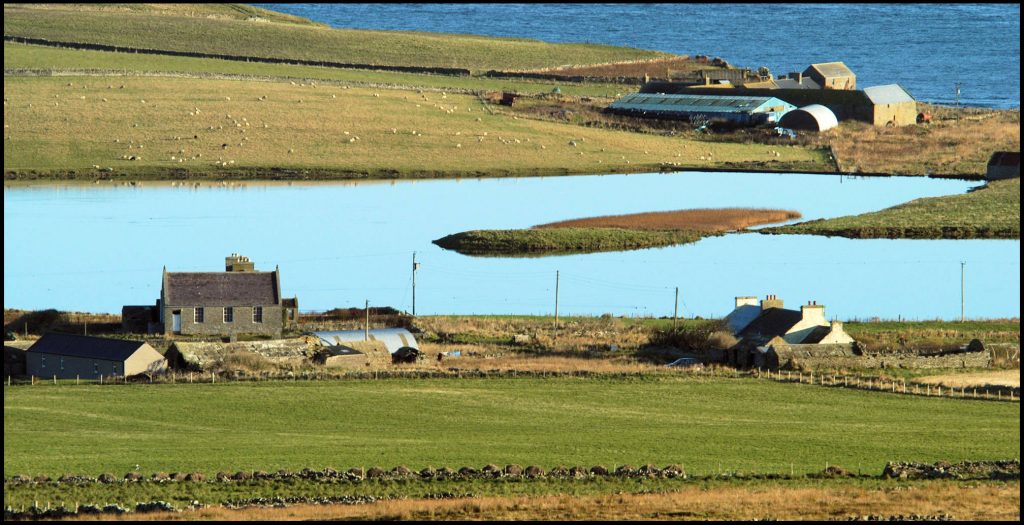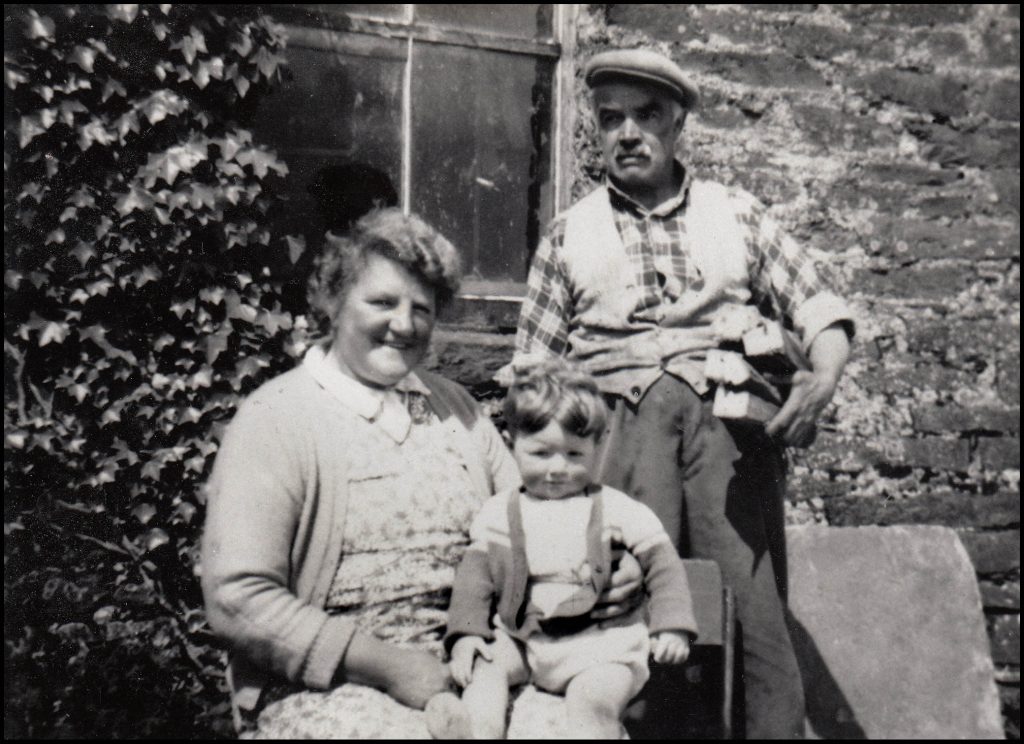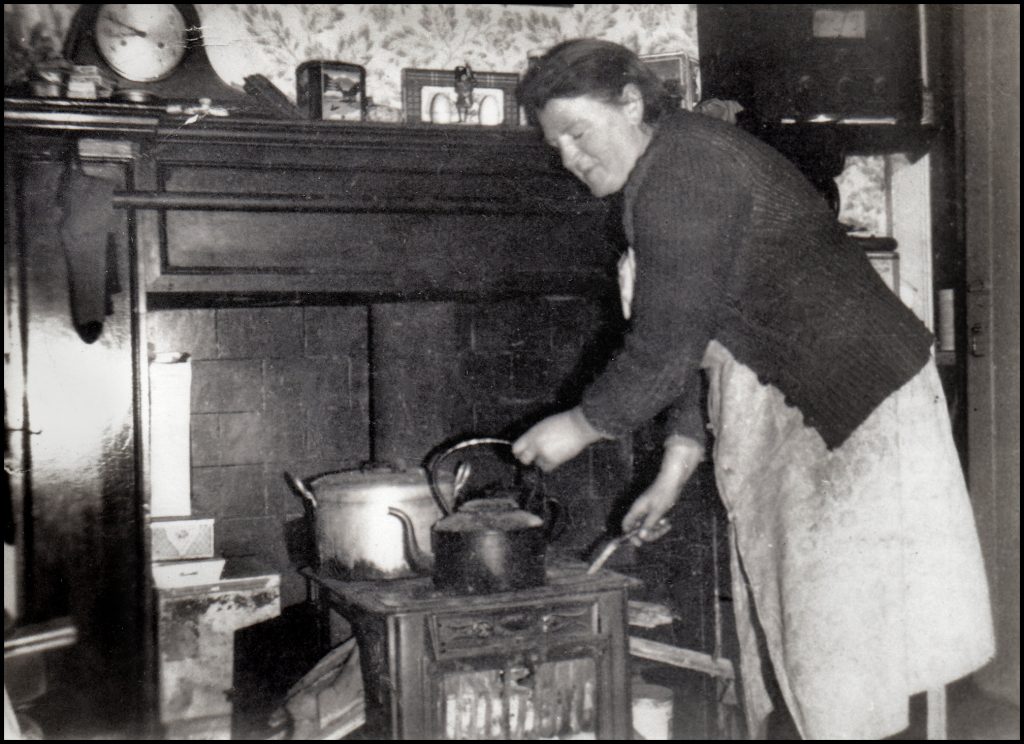by
Anita Thomson
The joiner shop at Ivybank in Wasbister, Rousay, started out as a school. It was built in the 1840’s or thereabouts under the auspices of the Rousay Free Church.
It remained a school until the School Board built a new one, across the road, which was opened in 1881 by General Burroughs.
My great-grandfather, William had been out working in the Hudson’s Bay Company’s territories for a few years in the Iate 1840’s – early 1850’s, and had there made enough money so that when he returned he married and set up a Grocer shop in one of the houses at Cogar. (His wife was an Inkster from Cogar). In the 1861 Census we find at Cogar, William Craigie, general merchant, 40; Margaret, his wife, 27; and family William, 6; Elizabeth, 3; and John, 1.
After the school moved across the road William and family must have moved into the oId schoolhouse and set up shop in the old school. Whether he had tenancy of the house earlier I don’t know but there is a story in the family of the first shop there being in what we knew as the back bedroom, with the oil barrels etc. standing in the wide passage leading through to it. He was also reputed to have had his own sloop, which brought his groceries etc. straight from Leith and landed them in the Bay of Saviskaill. (It may have been that he only owned a share in this boat along with some other merchants).
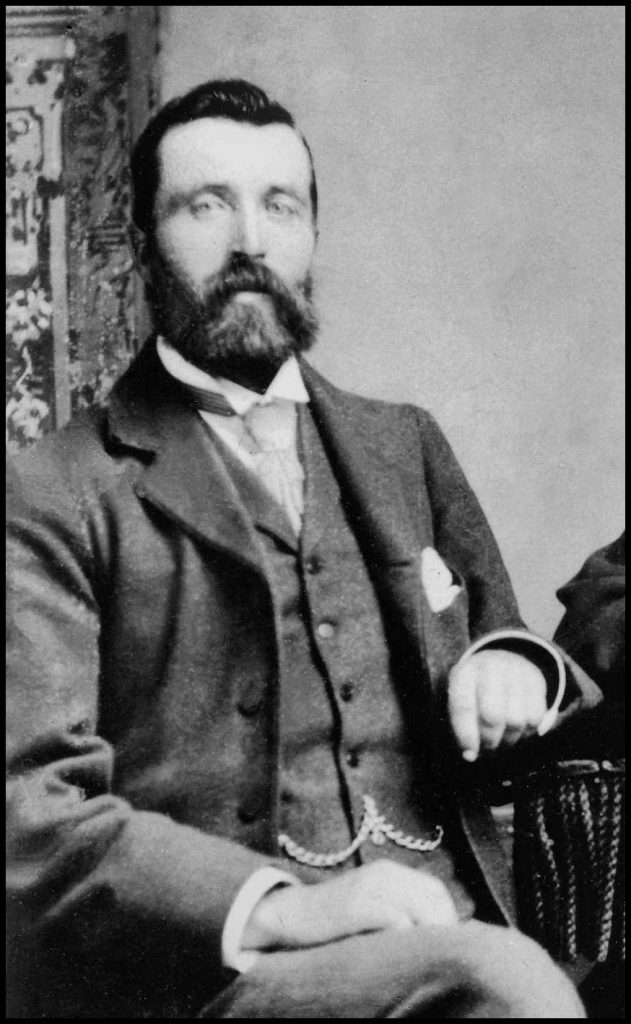
On William’s death in 1900 his son James (born 1862) and James’ new wife Annabella Chalmers (from Stronsay) carried on the business. Apart from being a shopkeeper James was also a crofter, a fisherman, a teacher, filling vacancies in the Rousay schools as welI as in Wyre ,Egilsay and Westray. He was appointed CIerk to the School Board in 1886 and continued in this post until the Boards were abolished in 1918. He was Inspector of the Poor and Clerk to the Parish Council for over 40 years until his death in 1927. As a result he was known aII over the island as “The Clerk” or “Clerkie”, and is pictured to the left.
James and Annabella’s children.
The eldest is Annie Flaws, born on February 21st 1901; William Marwick [the author’s father], born on April 18th 1902;
and youngest is Margaret Forest [known as Rita], who was born on July 5th 1908.
Back row, from left: Maggie Jane Clouston, Shalter; Hugh Sinclair, Vacquoy; Ellen Mary Craigie, Ploverha; John Marwick, Quoys; Maggie Inkster, Furse;
James Clouston, Tou; Jean Inkster, Swartafiold; David Flaws, Hammerfield; ?.; teacher Mattie Wards.
Middle row: Mary Jane Pearson, Kirkgate; James Craigie, Turbitail; Bessie Muir, Breckan; Hugh Craigie, Deithe; Maggie Jessie Flaws, Hammerfield;
James Marwick, Grain; William Craigie, Ivybank; Robert Inkster, Furse; Annie Craigie, Ivybank; Arthur Flaws, Hammerfield.
Front row: John Clouston, Shalter; James Sinclair, Blackhammer; Maggie Jessie Muir, Breckan; Liz Moar, Saviskaill; Ethel Inkster, Furse;
Annabella Sinclair, Sketquoy; Tony Sinclair, West Side School; Isabella Sinclair, West Side School.
~
Excerpt from Minutes of Meeting of Parish Council, held in Avelsay, 16th September 1927.
“Before proceeding with the business of the meeting, the Chairman made feeling
reference to the loss the Parish Council and the whole community had sustained
through the death of Mr. James G. Craigie, clerk to the council and Inspector of
Poor, for the long period of 40 years.
The Council unanimously agreed to record in their minutes their regret at the loss
they, as a Council had sustained, by the death of Mr. James G. Craigie, the high
appreciation of his long and faithful services, and their sincere sympathy with the
bereaved widow and family.”
(signed) AIlan C. Gibson, Clerk pro.tem. to Parish CounciI.
Unfortunately in 1921 the shop went on fire and burnt down, destroying all its contents. It was only through the expediency and hard work of their neighbours that the house itself was saved. All furniture etc. had been taken out of the parlour and bedrooms and laid on the field in front of the garden. I remember my grandmother saying that after the fire had been extinguished and everything had been brought in, only one cup had been broken.
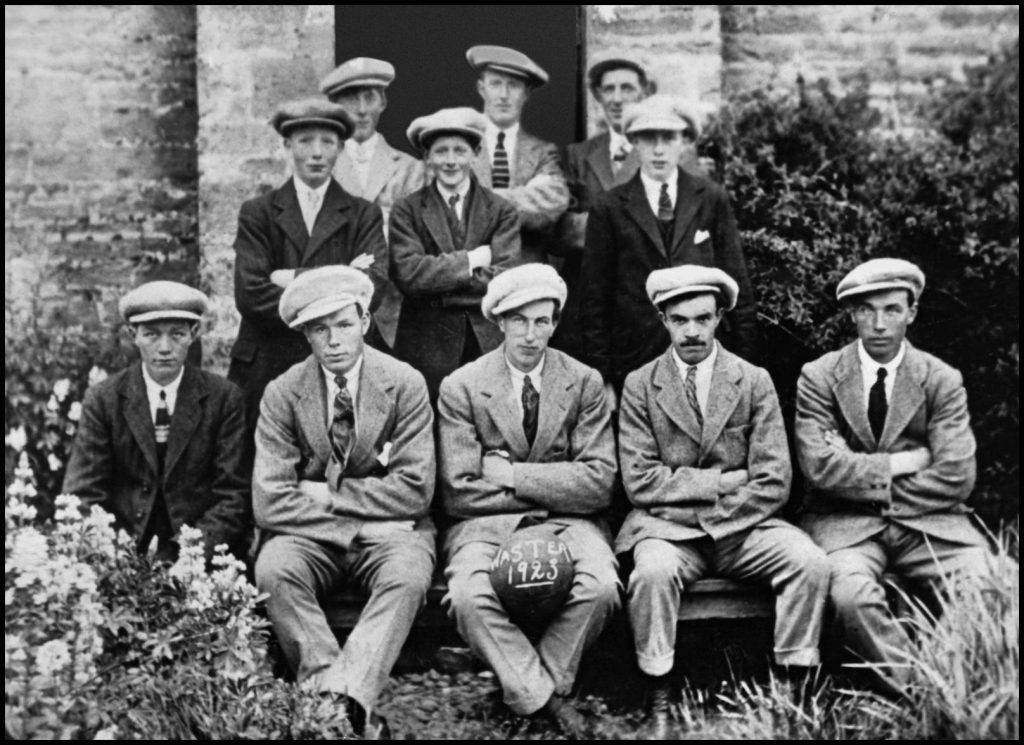
football team taken in 1923.
Back row, left to right: James Craigie, Feolquoy; James Clouston, Tou; James Marwick, Grain.
Middle row: Hugh Sinclair, Sketquoy; George Craigie, Feolquoy; ?.
Front row: Bill Flaws, Hammerfield; Robert Inkster, Furse; Malcolm Hourie, Maybank; William Craigie, Ivybank; James Craigie, Deithe.
Back row, from left: Annabella Clouston, Tou; Maggie Anne Craigie, Claybank; Ida Marwick, Grain; Ida Craigie, Turbitail;
Annie Craigie, Ivybank [teacher]; Liz Moar, Saviskaill; Lizzie Marwick, Whitemeadows.
Front row: Jim Craigie, Deithe; Annabella Sinclair, Sketquoy; Robert Sinclair, Vaquoy; Mary Anne Inkster, Cogar;
Hugh Sinclair, Sketquoy; Clara Clouston, Tou; James Craigie, Claybank
About that time my father William (Willie o’ the Shop) had just completed his apprenticeship as a joiner and cabinet maker. He had served his time with the Sinclairs of Vacquoy and then with Craigie and Inkster, Cabinet Makers in KirkwalI.
It was when he set up his Joiner-work business in Rousay that a new sheet iron roof was put on this building and it became his workshop. When I first remember, my grandmother had a little room in the front corner, which she called the ‘Office’. Perhaps it had been put there for a place for my grandfather to keep his boots and papers. It may have been situated where the old office had been but this had new wood lining. I can only remember hens meal being kept in it and the windows filled with red Geraniums, which Granny watered with cold tea. The only other thing of interest was an old, dirty cash box containing some black and burnt coins, memories of the fire. By the time I started school this partition was removed and the whole room was used as the workshop.
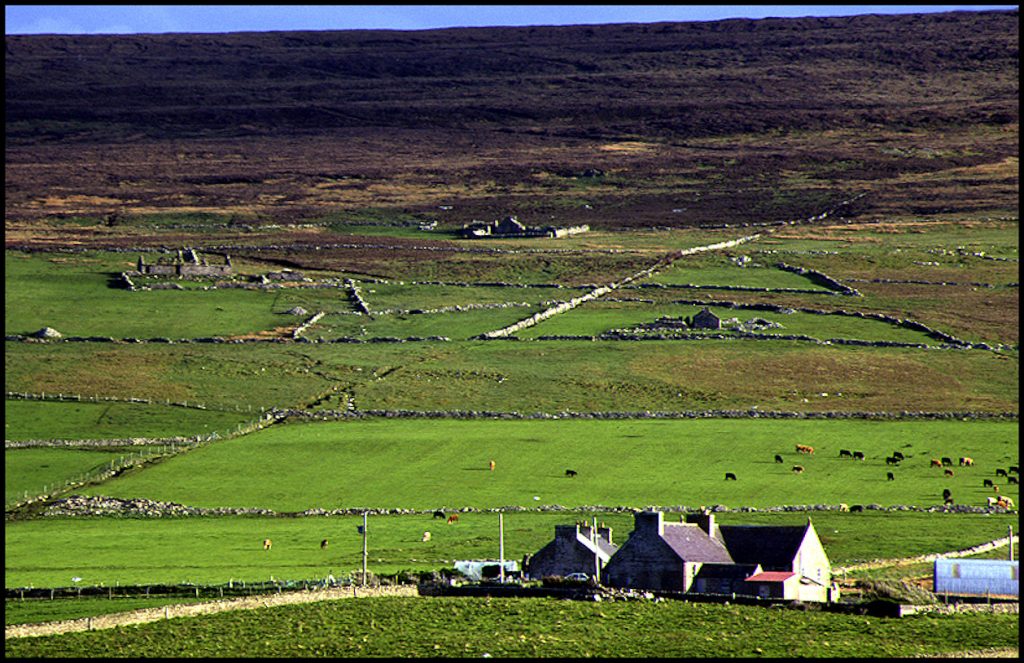
On the hill above at the ruins of Ploverha’, The Garret, and Shalter.
The Workshop was joined on to the east end of the house and faced South. There was a door, with the upper half in glass, in the middle of the south facing wall and a large window on either side. Directly opposite on the North wall were two similar windows, through which, late on a summer’s evening the rays of the setting sun would shine and blind your eyes as you entered the front door. The Easterly walI had no windows but there was a solid door in the southernmost corner. As one entered the front door, on the left was a big double-sided wood-working bench, with wooden vices on either side of it and a dip in the middle, which always got filled up with odd pieces of wood, shavings and sawdust. When we were thought to be old and responsible enough, probably about six or seven, it was our job to clean up the bench, carefully gather out the nails and small tools such as spokeshaves or screwdrivers. When we got tall enough we had to hang them up in their places. Saws, chisels and planes we did not touch and they were usually well up out of the road anyway. Along the wall adjoining the house, at the back of bench, were the shelves and hangers for his tools. Apart from ordinary joinery tools, he had many special woodworking and cabinet making ones. At one end of the bench stood his big heavy tool chest. Sometimes as a special treat, when we had finished our tidying we were allowed to make animals out of small offcuts of wood. This consisted of hammering a nail in each corner for legs and a longer, thicker one on the other side for a neck and head. If we were able to find a round piece, such as a cutting off a fork handle, we were thrilled and always called it a horse. These animals always went ‘missing’. No doubt when the novelty of playing with them wore off the nails were pulled out by our father and re-used.
Below the window to the right was his metalworking bench. It had a large metal vice about two thirds of the way along and a smaller one nearer the door. Underneath this bench were fitted drawers, which held his nails and bolts. All nails found on cleaning up days were sorted out and put in these drawers. It was often our job, when a new delivery of nails and screws arrived to put them in their appropriate drawers. These arrived in thick brown pokes and sometimes, if in Iarger quantities, in hessian sacks. There were usually several pounds of each size as my father sold quite a lot of nails to the farmers in the district. Screws were in much smaller quantities and were kept in jars on a shelf or in the brown cardboard boxes, with the yellow size label, that they arrived in. A shelf above held bottles of shellac, gum arabic and other varnishes and glues used in his furniture making and repairing. On the wall at the other side of the window were spanners, hacksaws etc. but many of the other tools often lay on the top of the bench along with pieces of sheet iron, and iron rods, while on the floor under the bench lay bigger pieces of metal. (He also had a smiddy with a forge, bellows and anvil in another building.)
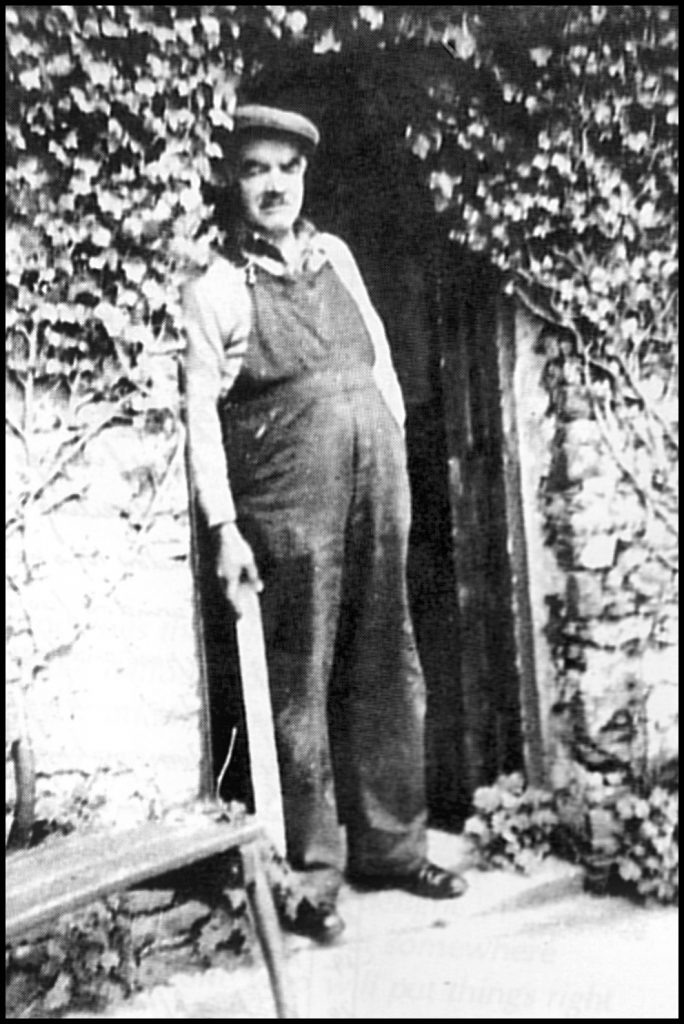
In the far (Nor’east) corner was his turning lathe. We used to enjoy help him work the foot pedal when he was turning out table or chair legs. It was absolutely fascinating to watch a square-cut piece of wood turn out into a graceful and intricately turned leg. Along the wall from the lathe he stored his wood, although many of the longer pieces were put up on the rafters. In the opposite back corner was the shelves and table where his battery charger was situated. This was powered by windmills fixed on the chimney-tops. Not only did he charge the wet batteries for many of the wirelesses in the neighbourhood, he also had a supply of electricity for our own lighting. In extreme gales these windchargers would blow down and have to be re-placed so quite often lying in the workshop were half-made blades waiting for such a happening.
Willie o’ the Shop
Among other things about the room were saw-benches, crates of glass, sheets of ply wood, a table with a piece of marble for mixing putty on. No ready-made putty in those days (Iate 1940’s). It was mixed from whitening and linseed oil. Among alI these bits and pieces of his trade was a space for bicycle parts for he once had an agency for bicycles and did those repairs.
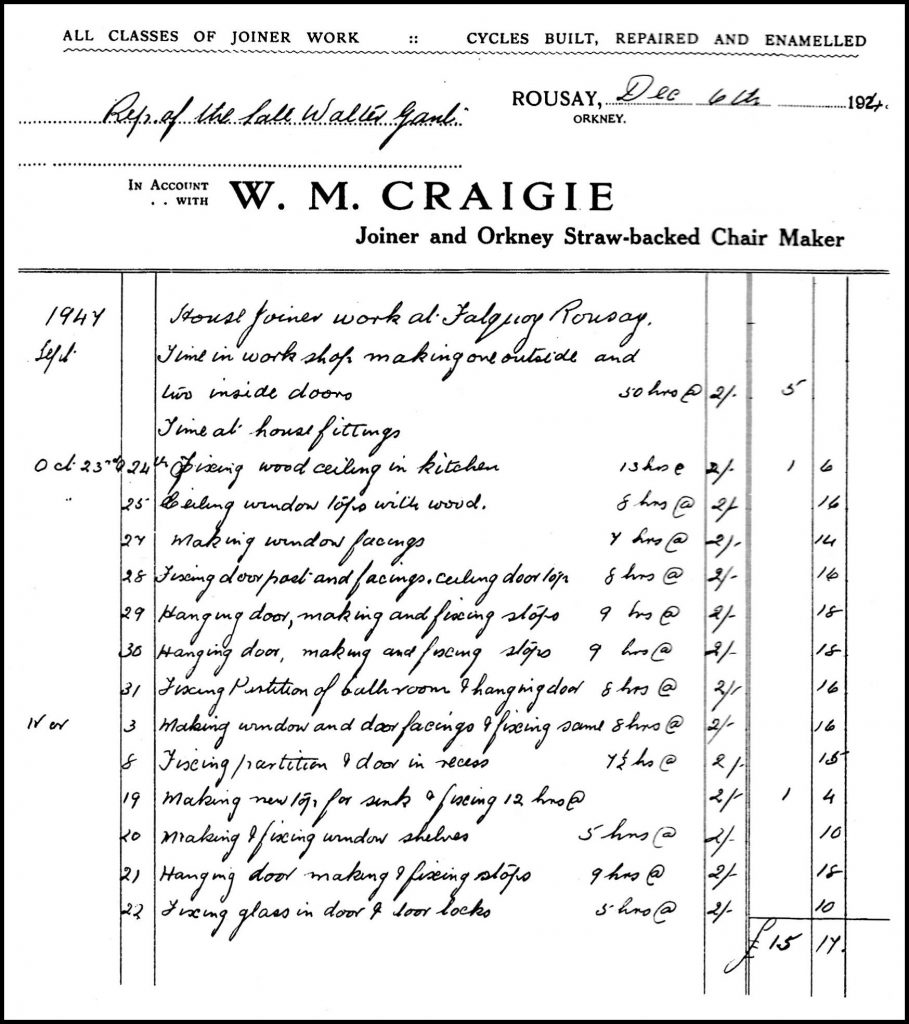
Although he was often away from home working, the shop would sometimes still be quite busy as lots of people came by wanting to buy nails or order pieces of wood. My mother often had to leave her washing or baking to weigh out nails or count out screws. They were usually put into small brown bags. These were marked down to the customer and every six months or so bills were made up and put out and eventually settled. Many small jobs he was called out to were very time consuming but were never charged for by the hour.
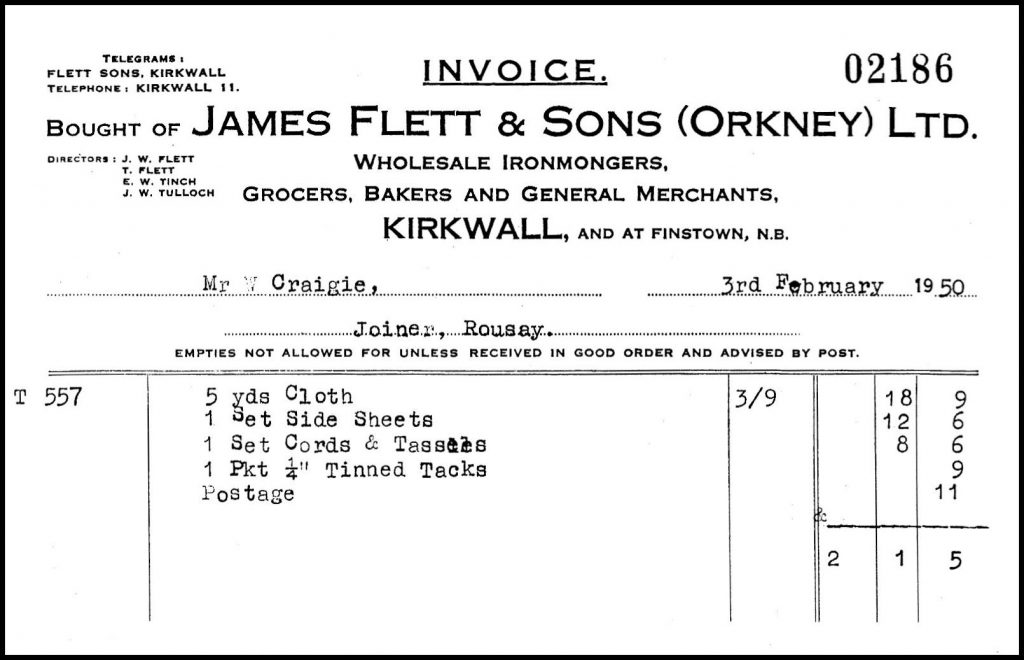
My thanks to Anita Thomson of Sanday for allowing the reproduction of her article,
which was first published in issue No. 77 of The Orkney View in 1998
The images of Willie o’ the Shop and the invoices are also Anita’s. The other black & whites
within the article are courtesy of the Tommy Gibson Collection.
